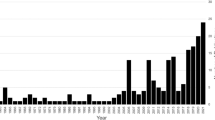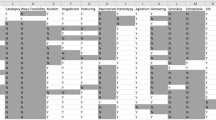Abstract
Background
There is increasing evidence that catatonia is an important source of impairment in adolescents and adults with autism.
Aim
Review of the evaluation, diagnosis, differential diagnosis, and treatment of catatonia in autism.
Method
Presentation and discussion of a case-vignette spanning early childhood to adulthood.
Results
Autistic and catatonic symptoms overlap, yet catatonia is diagnosable in about one of seven adolescents and young adults with autism. Case-reports suggest that benzodiazepines and electroconvulsive therapy are effective treatments in the acute and maintenance phase for people with autism who develop catatonia.
Conclusions
Catatonia should be assessed in people with autism when there is an obvious and marked deterioration in movement, vocalizations, pattern of activities, self-care, and practical skills. Benzodiazepines and electroconvulsive therapy are favored options for acute and maintenance treatment in these cases. Further studies on the possible biological-genetic overlap between autism and catatonia would be helpful.



Similar content being viewed by others
References
Abrams R (2002) Electroconvulsive therapy, 4th edn. Oxford University Press, New York
American Psychiatric Association (1994) Diagnostic and statistical manual of mental disorders, 4th edn. American Psychiatric Association, Washington, DC
Ayd F (1961) A survey of drug-induced extrapyramidal reactions. JAMA 175:102–108
Bailine S, Petraviciute S (2007) Catatonia in autistic twins: role of electroconvulsive therapy. J ECT 23:21–22
Bender K, Feutrill J (2000) Comatoid catatonia. Aust NZ J Psychiatry 34:169–170
Benegal V, Hingorani S, Khanna S (1993) Idiopathic catatonia: validity of the concept. Psychopathology 26:41–46
Billstedt E, Gilberg C, Gilberg C (2005) Autism after adolescence: population-based 13- to 22-year follow-up study of 120 individuals with autism diagnosed in childhood. J Autism Dev Disord 35:351–360
Brasic J, Zagzag D, Kowalik S, Prichep L, John E, Liang H, Klurchko B, Cancro R (1999) Progressive catatonia. Psychol Rep 84:239–246
Bumke O (1924) Lehrbuch der Geisterkrankheiten, 2nd edn. Bergmann, Munich
Caroff S, Mann S, Francis A, Fricchione G (2004) Catatonia. From psychopathology to neurobiology. American Psychiatric Publishing, Washington, DC
Carroll B, Goforth H (2004) Medical catatonia. In: Caroff S, Mann S, Francis A, Fricchione G (eds) Catatonia. From psychopathology to neurobiology. American Psychiatric Publishing, Washington DC
Chagnon Y (2006) Shared susceptibility region on chromosome 15 between autism and catatonia. Int Rev Neurobiol 72:165–178
Cohen D (2006) Towards a valid nosography and psychopathology of catatonia in children and adolescents. Int Rev Neurobiol 72:131–147
de Winter C, van Dijk F, Verhoeven W, Dhossche D, Stolker J (2007) Autism and catatonia: successful treatment using lorazepam. A case study. Tijdschr Psychiatr 49:257–261
DeLong R (2004) Autism and familial major mood disorders: are they related? J Neuropsychiatr Clin Neurosci 16:199–213
Dhossche D, Bouman N (1997) Catatonia in an adolescent with Prader–Willi Syndrome. Ann Clin Psychiatry 4:247–253
Dhossche D (1998) Catatonia in autistic disorders (brief report). J Autism Dev Disord 28:329–331
Dhossche D (2004) Autism as early expression of catatonia. Med Sci Monit 10:RA31–39
Dhossche D, Rout U (2006) Are autistic and catatonic regression related? A few working hypotheses involving GABA, Purkinje cell survival, neurogenesis, and ECT. Int Rev Neurobiol 72:55–79
Dhossche D, Shah A, Wing L (2006) Blueprints for the assessment, treatment, and future study of catatonia in autism spectrum disorders. Int Rev Neurobiol 72:267–284
Dhossche D, Wing L, Ohta M, Neumarker K-J (eds) (2006) Catatonia in Autism Spectrum Disorders. Elsevier, San Diego
Elia J, Dell M, Friedman D, Zimmerman R, Balamuth N, Ahmed A, Pati S (2005) PANDAS with catatonia: a case-report. Therapeutic response to lorazepam and plasmapheresis. J Am Acad Child Adolesc Psychiatry 44:1145–1150
Fink M (1995) Recognizing NMS as a type of catatonia. Neuropsychiatry Neuropsychol Behav Neurol 8:75–67
Fink M, Taylor M (2003) Catatonia. A clinician’s guide to diagnosis and treatment. Cambridge University Press, Cambridge
Fink M, Taylor M (2006) Neuroleptic malignant syndrome is malignant catatonia, warranting treatments efficacious for catatonia. Prog Neuropsychopharmacol Biol Psychiatry 30:1182–1183
Fink M, Taylor M, Ghaziuddin N (2006) Catatonia in autistic spectrum disorders: a medical treatment algorithm. Int Rev Neurobiol 72:233–244
Freudenreich O, McEvoy J, Goff D, Fricchione G (2007) Catatonic coma with profound bradycardia. Psychosomatics 48:74–78
Ghaziuddin M, Quinlan P, Ghaziuddin N (2005) Catatonia in autism: a distinct subtype? J Intellect Dis Res 49:102–105
Green W, Campbell M, Hardesty A, Grega D, Padron-Gayol M, Shell J, Erlenmeyer-Kimling L (1984) A comparison of schizophrenic and autistic children. J Am Acad Child Psychiatry 23:399–409
Hare D, Malone C (2004) Catatonia and autism spectrum disorders. Autism 8:183–195
Harris V (2006) Electroconvulsive therapy: administrative codes, legislation, and professional recommendations. J Am Acad Psychiatry Law 34:406–411
Hem E, Andreassen O, Robasse J-M, Vatnaland T, Opjodsoen S (2005) Should catatonia be part of the differential diagnosis of coma? Nord J Psychiatry 59:528–530
Hermesh H, Hoffnung R, Aizenberg D, Molcho A, Munitz H (1989) Catatonic signs in severe obsessive compulsive disorder. J Clin Psychiatry 50:303–305
Jimenez-Jimenez F, Garcia-Ruiz P, Molina J (1997) Drug-induced movement disorders. Drug Saf 16:180–204
Kakooza A, Stoppelbein L, Dhossche D (2006) Psychosis in autism. In: Fujii D, Ahmed I (eds) The spectrum of psychotic disorders: neurobiology, etiology & pathogenesis. Cambridge University Press, Cambridge, pp 233–246
Karadenizli D, Dilbar N, Bayam G (2005) Gilles de la Tourette Syndrome Response to Electroconvulsive Therapy. J ECT 21:246–248
Lachner C, Sandson N (2003) A case of catatonia-induced deep venous thrombosis. Psychosomatics 44:512–414
Larsson H, Eaton W, Madsen K, Vestergaard M, Olesen A, Agerbo E, Schendel D, Thorsen P, Mortensen P (2005) Risk factors for autism: perinatal factors, parental psychiatric history, and socioeconomic factors. Am J Epidemiol 161:1–10
Lopez-Canino A, Francis A (2004) Drug-induced catatonia. In: Caroff S, Mann S, Francis A, Fricchione G (eds) Catatonia. From psychopathology to neurobiology. American Psychiatric Publishing, Washington DC
Mahendra B (1981) Where have all the catatonics gone? (editorial). Psychol Med 11:669–671
McCall W, Mann S, Shelp F, Caroff S (1995) Fatal pulmonary embolism in the catatonic syndrome: two case reports and a literature review. J Clin Psychiatry 56:21–25
O’ Gorman G (1970) The nature of childhood autism, 2nd edn. Butterworths, London
Ohta M, Kano Y, Nagai Y (2006) Catatonia in individuals with autism spectrum disorders in adolescence and early adulthood: a long-term prospective study. Int Rev Neurobiol 72:41–54
Petrides G, Dhossche D, Fink M, Francis A (1994) Continuation ECT: relapse prevention in affective disorders. Convuls Ther 10:189–194
Petrides G, Divadeenam KM, Bush G, Francis A (1997) Synergism of lorazepam and electroconvulsive therapy in the treatment of catatonia. Biol Psychiatry 42:375–381
Rabheru K, Persad E (1997) A review of continuation and maintenance electroconvulsive therapy. Can J Psychiatry 42:476–484
Realmuto G, August G (1991) Catatonia in autistic disorder: a sign of comorbidity or variable expression. J Autism Dev Disord 21:517–528
Schieveld J (2006) Case reports with a child psychiatric exploration of catatonia, autism, and delirium. Int Rev Neurobiol 72:195–206
Shah A, Wing L (2006) Psychological approaches to chronic catatonia-like deterioration in autism spectrum disorders. Int Rev Neurobiol 72:245–264
Shorter E, Healy D (2007) Shock therapy: a history of electroconvulsive treatment in mental illness. Rutgers University Press/University of Toronto Press, Piscataway
Sienaert P, Peuskens J (2006) Electoconvulsive therapy: an effective therapy of medication-resistent bipolar disorder. Bipol Disord 8:304–306
Sporn A, Addington A, Gogtay N, Ordonez A, Gornick M, Clasen L, Greenstein D, Tossell J, Gochman P, Lenane M, Sharp W, Straub R, Rapaport J (2004) Pervasive developmental disorder and childhood-onset schizophrenia: comorbid disorder or a phenotypic variant of a very early onset illness? Biol Psychiatry 55:989–994
Stoppelbein L, Greening L, Kakooza A (2006) The importance of catatonia and stereotypies in autistic spectrum disorders. Int Rev Neurobiol 72:103–118
Suzuki K, Awata S, Takano T, Ebina Y, Iwasaki H, Matsuoka H (2005) Continuation electroconvulsive therapy for relapse prevention in middle-aged and elderly patients with intractable schizophrenia. Psychiatry Clin Neurosci 59:481–489
Trivedi H, Mendelowitz A, Fink M (2003) Gilles de la Tourette form of catatonia: response to ECT. J ECT 19:115–117
Wachtel L, Kahng S, Dhossche D, Cascella N, Reti I (2008) ECT for catatonia in an autistic girl. Am J Psychiatry 165:329–333
Watkins J, Asarnow R, Tanguay P (1988) Symptom development in childhood onset schizophrenia. J Child Psychol Psychiatry 29:865–878
Wing L, Shah A (2000) Catatonia in autistic spectrum disorders. Br J Psychiatry 176:357–362
Winslade W, Liston E, Ross J, Weber K (1984) Medical, Judicial, and Statuatory Regulations of ECT in the United States. Am J Psychiatry 141:1349–1355
Zaw F, Bates G, Murali V, Bentham P (1999) Catatonia, autism, and ECT. Dev Med Child Neurol 41:843–845
Zervas I, Fink M (1991) ECT for refractory Parkinson’s disease. Convuls Ther 7:222–223
Author information
Authors and Affiliations
Corresponding author
Rights and permissions
About this article
Cite this article
Kakooza-Mwesige, A., Wachtel, L.E. & Dhossche, D.M. Catatonia in autism: implications across the life span. Eur Child Adolesc Psychiatry 17, 327–335 (2008). https://doi.org/10.1007/s00787-008-0676-x
Accepted:
Published:
Issue Date:
DOI: https://doi.org/10.1007/s00787-008-0676-x




